Enhancement of thermal conductivity with al2o3 for nanofluids
Main Article Content
Abstract
The enhancement of the thermal conductivity of water in the presence of Alumina (Al2O3) using the employed surfactant, as the dispersant, is presented in this study. The volume concentration of Alumina–water nanofluids is below 0.2 vol.%. With the addition of dispersant and surfactant, the thermal conductivity of the produced nanofluids reveals a time-dependent characteristic. The thermal conductivity, considerably steady at the starting point of measurement, increases gradually with elapsed time. The results indicate that Alumina–water nanofluids with low concentration of nanoparticles have noticeably higher thermal conductivities than the water-base fluid without Alumina. For Al2O3 nanoparticles at a volume fraction of 0.001 (0.1 vol.%), thermal conductivity was enhanced by up to 18.4%.
Article Details
This work is licensed under a Creative Commons Attribution-NonCommercial-ShareAlike 4.0 International License.
References
FED-vol. 231/MD-vol. 66, The American Society of Mechanical Engineers, New York, pp. 99–105.
[2] Xuan, Y., Li, Q., 2000. Heat transfer enhancement of nanofluids, Int. J. Heat Fluid Flow, Vol. 21, pp. 58–64.
[3] Patel, H.E., Das, S.K., Sundararajan,T., Nair, A.S., George, B., Pradeep, T., 2003. Thermal conductivities of naked and monolayer protected metal nanoparticle based nanofluids:
manifestation of anomalous enhancement and chemical effects, Appl. Phys. Lett, Vol. 83, No. 14, pp. 2931–2933.
[4] Liu, M.S., Lin, M.C.C., Huang, I.T., Wang, C.C., 2005. Enhancement of thermal conductivity with carbon nanotube for nanofluids, Int. Commun, Heat Mass Transfer, Vol. 32,
pp.1202–1210.
[5] Liu, M.S., Lin, M.C.C., Huang, I.T., Wang, C.C., 2006. Enhancement of thermal conductivity with CuO for nanofluids, Chem. Eng. Technol, Vol. 29, pp. 72–77.
[6] Liz-Marzan, L.M., 2004. Nanometals formation and color, Materialstoday, pp. 26–31.
[7] Keblinski, P., Phillpot, S.R., Choi, S.U.S., Eastman, J.A., 2002. Mechanisms of heat flow in suspension of nano-sized particles (nanofluids). Int. J. Heat Mass Trans, Vol. 45, pp. 855-863
[8] Faraday, M., 1857. Deflagrations of gold. Philos. Trans. R. Soc, London, Vol. 147, pp. 145.
[9] Turkevich, J., Stevenson, P.C., Hillier, J., 1951. A study of the nucleation and growth of processes in the synthesis of colloidal gold. Trans. Faraday Soc., Vol. 11, pp. 55–75.
[10] Turkevich, J., 1985. Colloidal gold. Part I: historical and preparative aspects, morphology and structure, Gold Bull, Vol. 18, pp. 86–91.
[11] Bonnemann, H., Nagabhushana, K.S., 2004. Advantageous fuel cell catalysts from colloidal nanometals. J. New Mater. Electrochem. Syst., Vol. 7, pp. 93–108.
[12] Prasad, P.N., 2004. Nanophotonics. John Wiley & Sons, pp. 177–208.
[13] Koch, C.C., 2002. Nanostructured Materials: Processing, Properties and Potential Applications. William Andrew Publishing, Norwich, New York, pp. 3–50.
[14] Lee, S., Choi, S.U.S., Li, S., Eastman, J.A., 1999. Measuring thermal conductivity of fluids containing oxide nanoparticles. J. Heat Transfer, Vol. 121, pp. 280–289.
[15] Wen, X., Xie, Y., Choi, C.L., Wan, K.C., Li, X.Y., Yang, S., 2005. Copperbased nanowire materials: templated syntheses, characterizations, and applications. Langmuir, Vol. 21,
pp. 4729–4737.
[16] Li, C.C., Chang, M.H., 2004. Colloidal stability of CuO nanoparticles in alkanes via oleate modifications. Mater. Lett., Vol. 58, pp. 3903–3907.
[17] Klabunde, K.J., 2001. Nanoscale Materials in Chemistry. John Wiley & Sons, pp. 41–46.
[18] Jang, S.P., Choi, S.U.S., 2004. Role of Brownian motion in the enhanced thermal conductivity of nanofluids. Appl. Phys. Lett., Vol. 84, pp. 4316–4318.
[19] Vadasz, J.J., Govender, S., Vadasz, P., 2005. Heat transfer enhancement innanofluids suspensions: possible mechanisms and explanations. Int. J. Heat Mass Transfer, Vol. 48, pp. 2673–2683.



